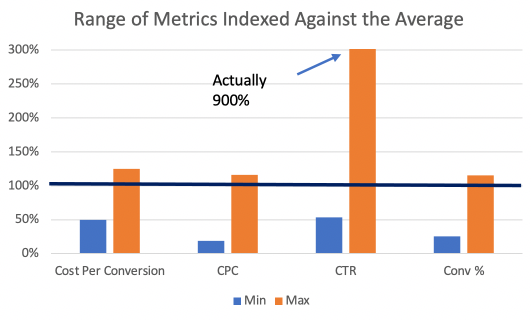Geotargeting optimization: How region impacts your PPC results
Geotargeting is a critical optimization tactic. Learn how analyzing paid search results by regions may unlock greater ROI.
Want to understand your paid search results? Geography is one of the most significant factors to analyze.
DIfferent words and brands mean other things based on location. For example, are you “soda” or “pop”? The same is true for brand names.
Read on to learn about geolocation results in paid search, how they vary and what to do with the variances.
Data: How PPC results vary across regions
For years I’ve had discussions with various brands about their performance by region. Should they be geotargeting? How does it impact bidding? Does it matter at all?
I pulled a data set to see how performance varied by geographies over the past year. Let’s start by looking at how results vary across regions. To understand the variances, I indexed each metric against the campaign totals or averages.
How much do the metrics vary? The first thing that jumps out is how wide the variance is, especially for CTR. We saw variance for all metrics of at least 2x and in the case of CTR as high as 15x. The minimums also vary much more than the maximums, except for CTR.

There was a significant difference by geographic region (in this case, “geographic region” means “states”). Why the big swings? Among the reasons;
- Brand awareness: Brands signify different things to different people based on locations. For example, a brand may be available nationally, but they were founded on the East or West Coast.
- Market competition: Regional players might only advertise in a given region that will influence the metrics.
- Keyword/bid strategy: The paid search managers of these accounts on a daily basis have something to say about the performance. They shift bids and keyword lists based on performance as a regular part of maintenance. This can have a natural influence on the metrics.
Get the daily newsletter search marketers rely on.
See terms.
The next thing I looked at was what would happen if I stopped spending in the lowest-performing 20 states. What would be the impact on my metrics?
A simple first step could be to stop spending the lowest-performing states. Using my data set, I viewed “lowest performing” by four categories:
1) Lowest conversion rates
2) Highest CPC
3) Highest Cost per Conversion
4) Lowest conversion rates
These categories all impacted the results pretty differently. Removing the lowest conversion kept the most revenue but didn’t improve the ROI.
Removing the highest cost per conversion improved the ROI the most but removed more than 30% of the total revenue. The impact on the ROI was pretty small, and the volume of results was reduced by up to 35%, based on this data.

So what if you took the lowest-performing states and poured that spend back into the top 20 performing states? The hypothesis showed improvement with all four scenarios increasing revenue vs. the baseline results.
The best scenario was removing the 20 states with the lowest costs-per-conversion and investing more in the states with the lowest cost-per-conversion. However, even in that scenario, the ROI and revenue didn’t increase more than 4% versus the baseline index.
Many companies would be ecstatic about the opportunity to increase revenue by 4% without any incremental costs. But for others, the juice wouldn’t be worth the squeeze.

What could alter this analysis?
- Assumptions on assumptions: A big assumption is that spending at higher levels and assuming the same throughput rates. The CPCs, conversion rates, or any of the metrics would be altered, impacting the results.
- Keywords within states: Viewing any of this data through the lens of only the geography doesn’t take into account all the other factors that weigh into performance. For example, even in a great performing state, there are specific keywords that are not performing well just as there are keywords in poor-performing states that are crushing it.
- Landing page and ad copy experiences.
- Brand type: Our data set has a mix of DTC online pure-plays and online/offline. I think local store mix and conversion types can all alter this analysis.
PPC actions to take?
Ultimately, the beauty of paid search is nothing operates in a vacuum. You have to consider the implications between the keyword, ad copy, bid, and landing page.
The correct answer isn’t just altering geotargeting. It takes the combination of these with audiences, time of day, device type and so many factors to truly drive results.
What I’m suggesting is that geotargeting can be yet another knob that can be dialed up and down and should be considered a critical optimization tactic. For example, if you want the ad copy and landing page to match the geography, geotargeting becomes more important from a user experience standpoint.
In some cases, it will complicate things to a level that doesn’t make the difference for your organization, and maybe a simple bid-modifier will do. In other cases, it could be the key to unlocking your results.
You can start simply with bid multipliers. My recommendation: dig into the data at this level, create a few tests and see if you can impact results in a meaningful way. Then you can determine if the test should be scaled up or back.
Opinions expressed in this article are those of the guest author and not necessarily Search Engine Land. Staff authors are listed here.
New on Search Engine Land
The latest jobs in search marketing
Master Google Ads conversion from clicks, to calls, to revenue
Google and Bing halt all ad sales in Russia
Google launches new Google Analytics 4 home page
Microsoft Advertising’s Ad Creator extracts site images for use in ads







